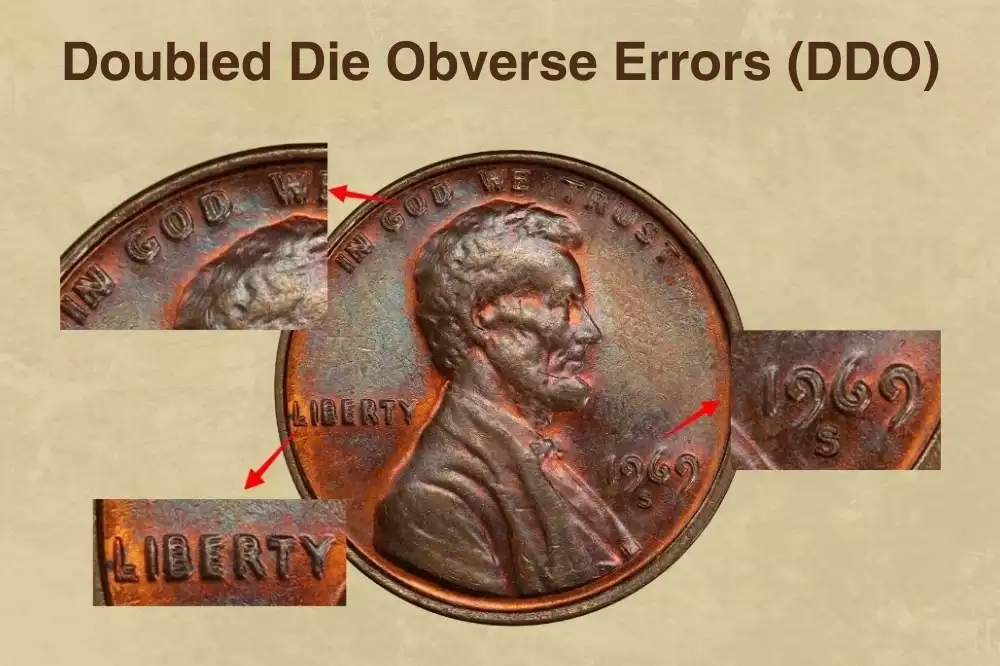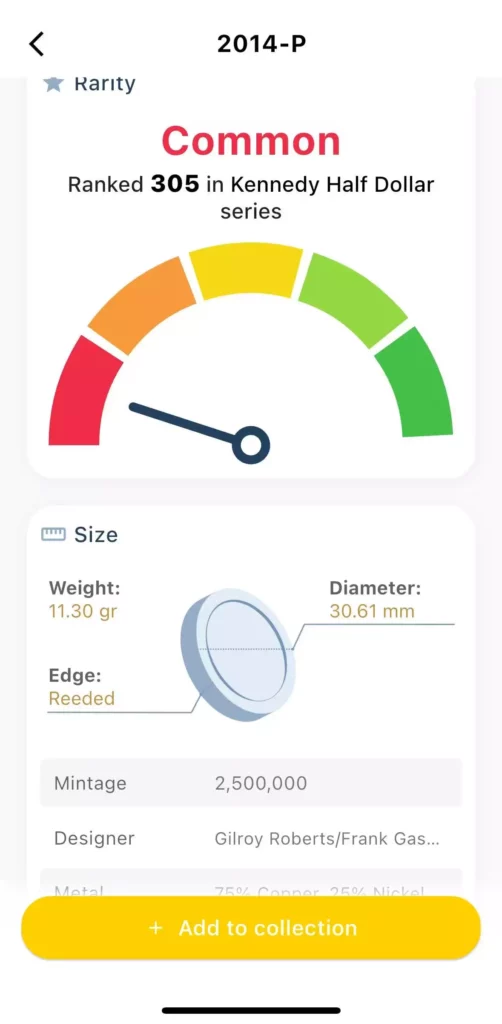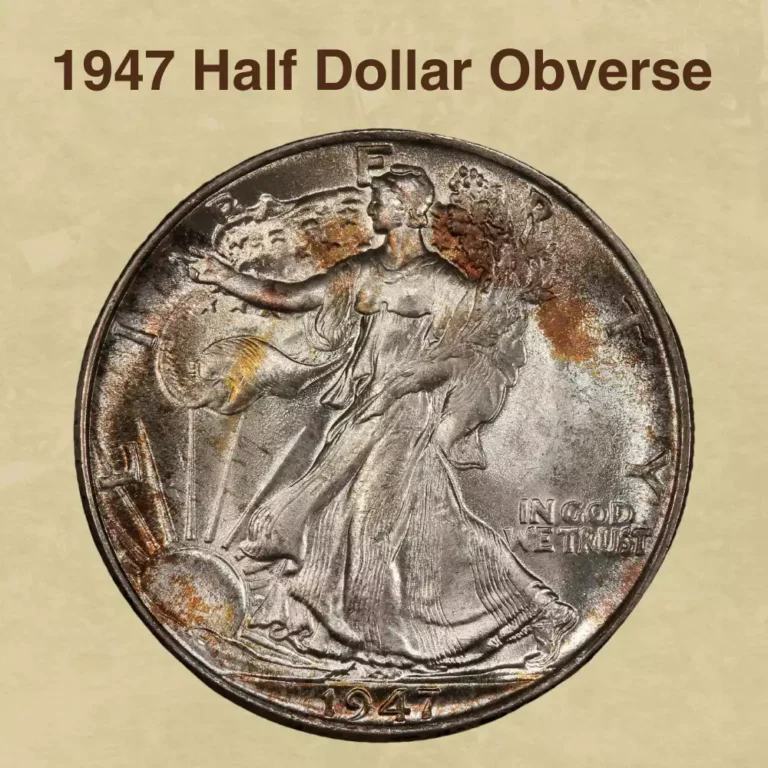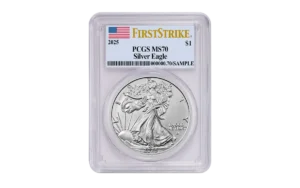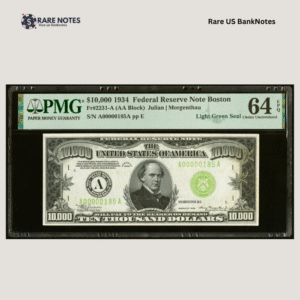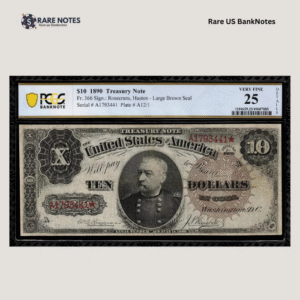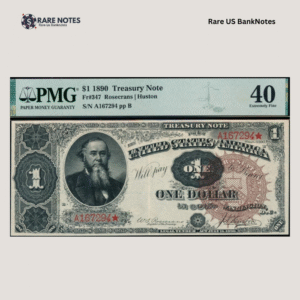Modern Lincoln cents (1959-2025) represent one of the most extensively studied series in American numismatics, offering collectors a rich variety of mint errors and die varieties.
These manufacturing anomalies, ranging from die varieties to striking errors, transform ordinary pennies into sought-after collectibles worth hundreds or thousands of dollars.
Error coins appeal to collectors because each represents a unique story of mechanical failure, human oversight, or equipment malfunction during the minting process.
Understanding these error types enables collectors to identify valuable specimens that might otherwise circulate unnoticed, making error coin collecting both educational and potentially profitable for those who know what to look for.
Modern Penny Die Variety Errors
1. Doubled Die Obverse (DDO) Errors

Doubled die obverse errors occur during the die-making process when the working hub impresses the design onto the working die more than once in slightly different positions. This creates doubled images of letters, numbers, or design elements on the coin’s obverse side.
In modern Lincoln cents, DDO manifestations typically appear in specific obverse elements. The most common locations include doubling in the date, “IN GOD WE TRUST,” “LIBERTY,” and Lincoln’s profile features.
Strong doubling is seen on the tops of the letters of the motto IN GOD WE TRUST, suggesting that a complete obverse design was hubbed over an incomplete design, with misalignment between the two images.
Notable modern examples include the famous 1969-S DDO and 1972 DDO varieties, along with discoveries like the 1995 doubled die Lincoln cent that surfaced as the first new major doubled die Lincoln cent in more than a decade.
Values vary dramatically, with premium examples like the 1969-S commanding thousands of dollars, while a minor but exceedingly rare 1972 Doubled Die Obverse Lincoln cent graded PCGS MS-66 RD sold for $21,811. Less dramatic DDO varieties from other years typically command modest to moderate premiums among variety collectors.
Known DDO Error Years for Modern Lincoln Cent (1959-Date):
2. Doubled Die Reverse (DDR) Errors

Doubled die reverse errors form during the die-making process when the working hub creates multiple impressions on the working die at slightly different positions or angles. The formation process involves mechanical misalignment during the hubbing process, where the hub that creates the reverse design is impressed more than once onto the die face.
In modern Lincoln cents, DDR errors manifest differently across the two main reverse designs.
During the Memorial period (1959-2008), doubling typically appears on the Lincoln Memorial columns, steps, or inscriptions like “ONE CENT” and “UNITED STATES OF AMERICA.” In the Shield period (2010-present), DDR errors show doubling in the shield’s vertical stripes, horizontal bands, or surrounding text elements.
DDR errors are generally less valuable than their DDO counterparts because the reverse design changes are often subtler and less noticeable to casual observers. Values typically range from $50-$5,000 depending on the year, severity of doubling, and coin grade. The 1983 DDR is among the most valuable, with high-grade examples reaching several thousand dollars.
Known DDR Error Years for Modern Lincoln Cent (1959-Date):
3. Repunched Mint Mark (RPM) Errors

When the Mint started using mint marks in the early 1800’s to identify the various branch mints, the mint mark was hand punched into the working dies. A die maker would take a thin steel rod (punch) that had the mint mark engraved on it and manually hammer it into each working die.
The human element created inevitable errors. If the initial punch wasn’t properly positioned or deep enough, die makers would re-punch the mint mark, often slightly offset from the original. This created the distinctive “shadow” effect we call a “repunched mint mark (RPM) error,” where you can see multiple impressions of the same letter—like D/D or S/S varieties.
Notable examples of modern cents include the 1959 D/D/D RPM FS-501, which features three different “D”s. A 1959 D/D/D RPM MS66 RD sells for over $800. The 1968-D/D and 1987-D/D are also well-documented RPMs that collectors actively seek. Values of these RPM error coins typically range from $15-$500.
What makes RPMs particularly interesting is their historical significance—they represent the last era of hand-crafted coin production before automation eliminated such errors. By the 1990s, computerized processes largely eliminated RPMs, making earlier varieties increasingly appreciated as artifacts of traditional craftsmanship.
Known RPM Error Years for Modern Lincoln Cent (1959-Date):
4. Over Mint Mark (OMM) errors

An Over Mint Mark (OMM) is a distinct numismatic variety where two different, overlapping mintmarks are present. The obscured mintmark (the one that is punched in first) is usually thinner and smaller than the definitive mintmark. This technical distinction separates OMMs from Repunched Mint Marks (RPMs), where the same mint mark appears multiple times.
The formation process involves deliberate die modification during production. This may be due to having been weakly punched into the working die or it may reflect an attempt to abrade (remove) the first mintmark before punching in the second mintmark.
The most documented examples are the 1974-D/S Lincoln cents, it demonstrate wartime production pragmatism—San Francisco dies were reassigned to Denver Mint operations due to die shortages. The original “S” mint mark was partially ground away before the “D” was punched over it, but remnants of the underlying “S” remain visible under magnification.
OMMs are significantly rarer than RPMs due to their specific formation requirements involving two different mint facilities. Values range from $200-$2,000+ depending on the visibility of the underlying mint mark and coin grade, making them highly sought after by advanced collectors specializing in mint mark varieties.
Known OMM Error Years for Modern Lincoln Cent (1959-Date): 1974
Modern Penny Planchet Errors
5. Wrong Planchet Errors (penny on dime planchet, nickel planchet, etc.)

Wrong planchet errors, also called off-metal strikes, occur when Lincoln cents are accidentally struck on planchets intended for other denominations. A planchet is the blank disk of metal, featureless except for a slightly raised proto-rim on both sides, used to strike a coin. These dramatic errors result from production line mix-ups where different denomination planchets become commingled in the striking chambers.
The most common wrong planchet varieties include pennies struck on dime planchets (creating silver-colored cents), nickel planchets (producing larger, heavier cents), and occasionally foreign planchets. A 1959-D Lincoln cent… was struck on a silver planchet intended for a Roosevelt dime, demonstrating how these errors occur when planchet bins are accidentally mixed or cross-contaminated during the production process.
Values vary significantly based on the host planchet’s composition and rarity. Pre-1965 silver dime planchets command premium prices due to their silver content and historical significance. The rare 1973 Lincoln Penny struck on a dime planchet has been valued at $26,400, while typical wrong planchet errors range from $500-$5,000+ depending on grade and scarcity.
These errors are immediately recognizable due to their distinctive weight, size, and often color differences, making them among the most visually dramatic mint errors that even novice collectors can easily identify.
Known Wrong Planchet Error Years for Modern Lincoln Cent (1959-Date):
6. Unplated/Incomplete Plating Errors
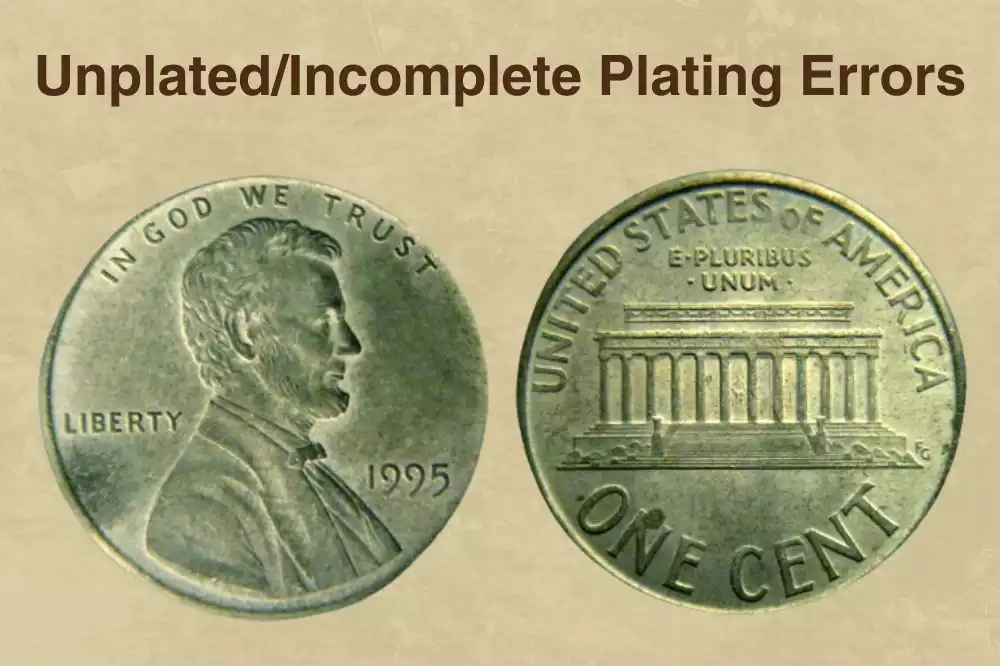
Unplated and incomplete plating errors represent a significant category of Lincoln cent mint errors that became possible only after 1982, when the U.S. Mint transitioned from solid bronze composition to copper-plated zinc planchets.
These errors occur when zinc planchets either completely miss the copper electroplating process or receive insufficient copper coating, exposing the underlying zinc core. Documented examples include unplated 1984 and 1995 Lincoln cents, with these errors creating distinctive silvery-white appearances due to the exposed zinc surface.
These errors hold historical significance as they directly relate to the 1982 compositional change, representing transitional period minting irregularities.
The value of these error coins depends on their year and condition. Genuine unplated pennies are highly sought after by error coin collectors due to their rarity and visual impact. Counterfeits of these error coins are common, typically created outside the mint by chemically removing the copper plating from ordinary pennies. Therefore, careful authentication is crucial to distinguish genuine mint errors from artificially created specimens.
Known Unplated/Incomplete Plating Error Years for Modern Lincoln Cent (1959-Date):
7. Split Planchet Errors

A split planchet coin error occurs when, during the preparation of the planchet strip, impurities such as gas, dirt, or grease become trapped under the surface of the metal blank, creating a weakness or lamination defect. The contamination creates internal stress points that compromise the metal’s structural integrity.
These defects manifest when this weak area of the metal may flake, peel, or split because the adhesion is poor. The splitting can occur before or after striking, creating dramatic visual effects where portions of the coin appear to separate along horizontal planes.
What makes these errors particularly intriguing is their unpredictability—the same contamination that creates weakness might not manifest until years after striking, when environmental factors trigger the final separation. Split planchet errors are normally restricted to planchets composed of a solid alloy, such as U.S. cents and nickels.
Values depend heavily on the extent and dramatic nature of the split, ranging from $75-$800+. Coins with complete layer separation or unusual splitting patterns command higher premiums among error coin specialists.
Known Split Planchet Error Years for Modern Lincoln Cent (1959-Date):
8. Defective Planchet Errors

A defective planchet is a planchet with any number of problems and these problems occur before the strike and usually happen during the planchet manufacturing process, distinguishing them from striking errors that occur during coin production.
These defects include various metallurgical and physical imperfections: incomplete annealing creating uneven metal hardness, roller marks from improper strip preparation, pitting and surface irregularities from contaminated alloys, and dimensional variations from faulty cutting operations.
Modern zinc-core Lincoln cents are particularly susceptible to plating defects, gas bubbles trapped during the electroplating process, and core-to-plating adhesion failures. These manifest as unusual surface textures, weight variations, or visible core exposure before striking.
Values of these coins typically range from $25-$400 depending on the severity and visual impact of the defect. Despite its circulated state, it is still a valuable addition to any collection due to its rarity and unique features, particularly for dramatic examples showing multiple concurrent defects or unusual manufacturing anomalies.
Known Defective Planchet Error Years for Modern Lincoln Cent (1959-Date):
Modern Penny Striking Errors
9. Off-Center Strikes Errors (various percentages)

Off-center strikes occur when the planchet is improperly positioned in the coining chamber during the striking process. Off-center coins happen during the striking process when the coin does not align properly in the coining press. This misalignment results in only a portion of the design being impressed on the planchet, creating dramatic visual errors where part of the coin remains blank while design elements are cut off or missing.
All off-center coins are missing some part of the design on at least one side of the coin, which can include the lettering, central design detail, or the dentils on the coin’s rim. The severity is measured by percentage—a 50% off-center strike means half the design is missing, while a 90% off-center coin shows only a small portion of the original design.
Value depends heavily on the percentage of off-centering and whether the date remains visible. The value of off-center strikes depends on the amount off-center and the amount of wear. Based on documented cases, 1968 pennies, 1970-D cents, and 1978 Lincoln pennies have been found with off-center strikes, with values ranging from $75-$500+ depending on the degree of misalignment and overall condition.
Known Off-Center Strikes Error Years for Modern Lincoln Cent (1959-Date):
10. Double Strikes Errors

Double strike errors occur when a coin receives two impressions from the dies during the minting process.
This happens when a coin fails to eject properly from the press after the initial strike and remains in position for a second impact. The second strike can be centered, off-center, or rotated, creating distinctive overlapping images that make the design elements appear doubled or displaced.
Formation typically results from mechanical malfunctions in the coining press ejection system, causing the struck coin to remain in the collar or die area. The severity and type of doubling depends on the coin’s position during the second strike.
These errors have become increasingly rare since 2002 when the U.S. Mint implemented enhanced quality control systems that prevent most major errors from leaving the facility. This scarcity has enhanced their collectible value significantly.
Values vary considerably based on the year, condition, and dramatic nature of the doubling effect, with more pronounced errors commanding higher premiums among specialized error coin collectors. In-collar double strikes typically range from $75-$300, while dramatic off-center double strikes can command $200-$1,000+.
Known Double Strikes Error Years for Modern Lincoln Cent (1959-Date):
11. Broadstruck Errors

Broadstruck errors occur when a coin is struck without the presence of a retaining collar, the metal ring that normally constrains the planchet during striking.
When the retaining collar fails to function correctly, the metal flows outward unrestricted during the striking process, creating coins that are thinner and wider than normal specimens. These errors must display the complete design to qualify as broadstrikes rather than off-center strikes.
Market values for broadstruck Lincoln cents vary significantly based on year, condition, and dramatic nature of the error. They may be worth $9 to $25, depending on how wide and apparent their error looks. A 1999 broadstruck Lincoln cent graded NGC MS64 RD that sold for $9.52 in June 2019. While this represents a modest value, more examples from scarcer years or higher grades can command substantially higher premiums.
More dramatic examples with significant size increases can command higher premiums as well. Depending on the denomination and the coin’s condition, a significant size broadstrike error coin can be worth anywhere from $5 to $1,000… on up!
These errors remain collectible due to their distinctive appearance and the mechanical failure story they represent, making them attractive to specialized error coin collectors seeking unusual minting anomalies.
Known Broadstruck Error Years for Modern Lincoln Cent (1959-Date):
12. Brockage Errors

Brockage errors create one of the most visually striking mint errors, featuring a mirror image of one side of the design impressed on the other. This occurs when an already minted coin sticks to the die surface instead of falling off. This coin then leaves an impression of its reverse or obverse design on the incoming blank planchet.
The formation process involves a mechanical failure where when a coin sticks to the upper or lower die a number of brockage strikes may occur from the same coin (which at this stage is known as a “die cap”). The first strike from the “capped die” will result in a “mirror brockage” that will exhibit a perfect incuse mirror image of the design. This creates a sunken, reversed impression instead of the normal raised relief.
Mirror brockages in the Modern Cent series are extremely rare, making them highly sought after by collectors.
Brockage examples include a 2020 Lincoln cent brockage error and recent discoveries where the obverse features typical Lincoln portrait while the reverse shows mirrored impression with visible backward letters. Values can reach thousands of dollars for clear, dramatic examples, with pricing dependent on the completeness and clarity of the mirror image.
Known Brockage Error Years for Modern Lincoln Cent (1959-Date):
13. Uniface Strikes Errors
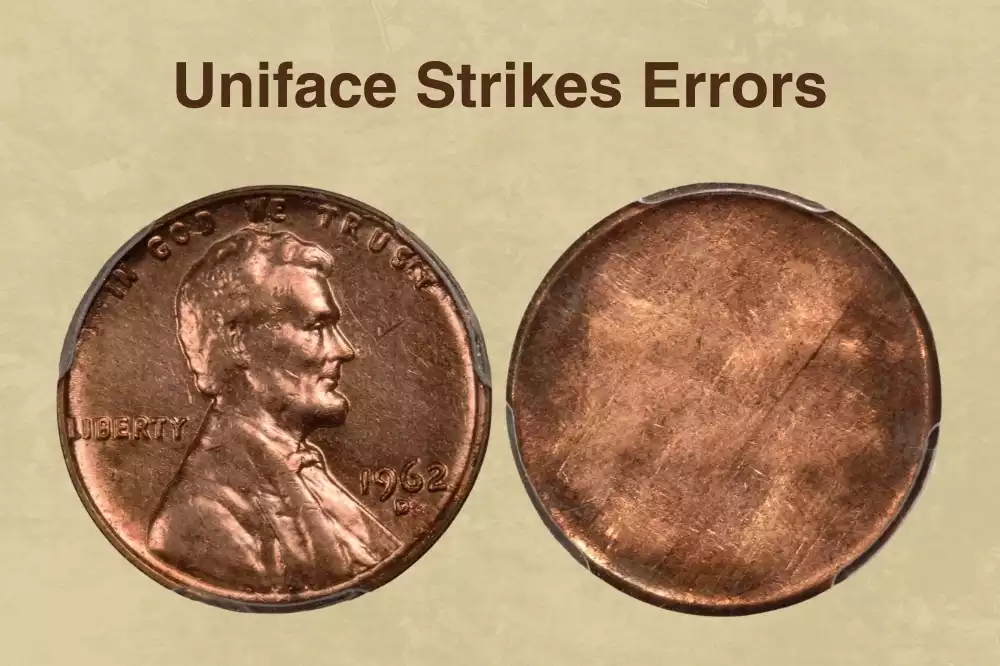
Uniface strikes are dramatic mint errors where a coin displays a complete design on one side while the other side remains completely blank or shows minimal impression.
The formation mechanism involves multiple planchets accidentally stacking in the striking chamber. When the press operates, the upper planchet receives the full impression from one die, while the lower planchet prevents the opposite die from creating its design. The result is a coin with normal relief on one side and a blank, unstruck surface on the other.
These errors are extremely rare because modern high-speed coining operations have sophisticated feeding mechanisms designed to prevent multiple planchet scenarios. Quality control systems typically catch such dramatic errors before coins reach circulation, making authentic examples highly sought after by collectors.
If the uniface coin is a trial strike, die cap error, or two planchet error, it has strong collector value due to their rarity and visual impact. The 1984 uniface reverse strike penny error represents a documented case in the Modern Lincoln series, which fetch up to $155 or more, depending on the coin’s condition, demonstrating the premium collectors place on these rare striking anomalies.
Known Uniface Strikes Error Years for Modern Lincoln Cent (1959-Date):
Modern Penny Die Damage and Related Errors
14. Die Breaks/Cracks Errors

Die breaks and cracks errors occur when the steel dies used to strike coins develop fractures due to metal fatigue, excessive use, or manufacturing flaws. Hairline cracks may begin showing on aging dies — and these cracks on the die can result in raised lines on the coin. These lines (called die cracks or die breaks) appear as raised metal ridges on the struck coins.
There are several types of die breaks: interior die breaks (appearing within the coin’s design), marginal die breaks or “cuds” (occurring at the rim), and die cracks (linear fractures across the die surface). When metal flows away from areas affected by die breaks, it creates flatness in the strike, which is actually part of the error itself.
Die break varieties have been recorded throughout the modern series, including examples from 1974-S, 1975-D, and 1979 varieties, though specific premium values for individual years vary based on the severity and visual appeal of the particular die break. An example with this striking error may be worth $5 up to $25. Some are worth $100 or more for higher grade examples.
Known Die Breaks/Cracks Error Years for Modern Lincoln Cent (1959-Date):
15. Die Cuds Errors

Die cuds are a specific type of die break error.
A cud is a raised area on the rim of a coin’s surface caused by a die break where a piece of the die is missing. When the broken piece falls out completely, it creates a void that fills with metal during striking, forming a raised, blob-like area on the finished coin.
Modern Lincoln cents show documented cud errors throughout the 1959-2025 period. Examples include cuds from the 1980s decade and recent discoveries like a 2025-S Lincoln Shield cent with a rim cud break on the reverse.
Some die break error coins are worth $100 or more, depending on their rarity and dramatic appearance. Values depend on the size and location of the cud, with larger, more prominent cuds commanding higher premiums in the error coin market.
Known Die Cuds Error Years for Modern Lincoln Cent (1959-Date):
16. BIE Errors (die break between B and E in LIBERTY)

BIE errors are a specific type of die break exclusive to Lincoln cents that occurs between the letters “B” and “E” in the word “LIBERTY” on the obverse. The die break between the B and E looks something like an I, so it’s called B-I-E or BIE error. This creates the appearance of an extra letter “I” making “LIBERTY” appear as “LIBIERTY.”
The formation results from metal fatigue causing a crack or chip in the die surface between these specific letters. Die chips that cause protrusions or blobs to appear on struck coins were unusually common on U.S. coins of most denominations struck during the 1950s and early 1960s.
BIE errors are among the most collectible Lincoln cent varieties because they’re easily recognizable to novice collectors and occur frequently enough to make collecting feasible.
Values vary based on year, condition, and prominence of the BIE feature, with some examples commanding modest premiums among specialized variety collectors who appreciate these distinctive die break errors.
Known BIE Error Years for Modern Lincoln Cent (1959-Date): 1960
17. Die Chips Errors

Die chips are small pieces of metal that break away from the coin die surface during the striking process, creating distinctive raised metal bumps or irregular protrusions on struck coins. These errors form when the repeated stress of high-pressure coin production causes small fragments of the hardened steel die to fracture and separate from the main die surface.
The formation process involves metal fatigue from thousands of striking cycles. As dies age, micro-cracks develop in areas of high stress concentration. Temperature fluctuations during production can accelerate this deterioration. When a small piece of the die finally breaks away, subsequent coins struck by that die will show a raised metal blob where the missing die piece should have created normal surface detail.
Die chips differ from die breaks or cuds in that they’re typically much smaller and more isolated. They often appear as small raised dots or irregular metal bumps scattered across the coin’s surface, rather than the larger, more dramatic features associated with major die breaks.
Die chip errors generally command modest premiums in the collector market, typically ranging from $10-$35 depending on the size, location, and visual prominence of the chip.
Known Die Chips Error Years for Modern Lincoln Cent (1959-Date):
18. Die Clash Errors

Die clashes are a type of error coin resulting when when the coining press experiences a mechanical malfunction, causing the obverse and reverse dies to come into direct contact. This creates faint impressions of one die’s design transferred onto the opposite die surface.
Die clash errors are categorized as typical die clashes (TDC) and atypical die clashes (ADC). Values are generally modest, typically ranging from a few dollars to moderate premiums depending on the prominence of the clash marks and the specific year, with most examples valued for their technical interest rather than significant monetary worth.
Known Die Clash Error Years for Modern Lincoln Cent (1959-Date):
Modern Penny Special Strike-Through Errors
19. Standard Strike-Through Errors

Standard Strike-Through Errors occur when foreign object comes between the die and the blank when it is being struck. The foreign object becomes impressed into the blank’s surface, and it distorts the finished product.
Formation results from foreign matter plugs the cavity into which the planchet’s metal would normally flow under the striking pressure, causing missing design elements where the object blocked proper contact.
The most common and likely to make its way into circulation is a mistrike known as a strikethrough. These errors display incomplete design elements with smooth or textured areas where foreign objects interfered during striking. The object or substance itself will not be “retained” on the coin, distinguishing standard strike-throughs from retained varieties.
Most struck throughs are extremely small, caused when tiny pieces of dust or other nearly microscopic particles are inadvertently struck into a coin. Identification requires examining areas with missing design details that show clear boundaries and may retain texture impressions from the interfering material.
Market values depend on the size, location, and visual impact of the strike-through area. While specific documentation of modern cent years with standard strike-through errors is limited, errors can occur in any year, making every Lincoln cent potentially valuable.
Known Standard Strike-Through Error Years for Modern Lincoln Cent (1959-Date):
20. Retained Strike-Through Errors

Retained strike-through errors, also known as embedded struck-through errors, occur when foreign objects become permanently embedded in the coin’s surface during the striking process.
The formation happens when debris such as cloth, grease, paper, wire fragments, or other materials gets trapped between the die and planchet during striking. Unlike standard strike-through errors where the object falls away, retained errors involve the foreign material becoming permanently fused into the coin’s surface under the immense striking pressure.
Modern Lincoln cents show documented retained strike-through errors across multiple years. Examples include a 1970-D cent with retained strike-through error and a 1959-D Memorial cent.
Values retained strike-through coins depend on the size, location, and nature of the embedded material. Retained strike-through errors typically command higher premiums than standard strike-through errors due to their dramatic appearance and the rarity of having foreign material permanently embedded in the coin.
Known Retained Strike-Through Error Years for Modern Lincoln Cent (1959-Date):
Modern Penny Special Errors
21. Die Cap Errors (obverse/reverse)

Die cap errors occur when a coin sticks to the hammer die and if it remains on the die long enough it will spread around the outside of the die, forming what looks like a bottle cap. As it continues to strike more coins, the cent that is stuck to the die becomes shaped like a bottle cap, hence the name “Capped Die”. These errors progress through stages as the cap remains on the die and strikes additional planchets.
The first planchet struck after formation of the cap will be left with a clear, complete brockage of the obverse design on the reverse face. Subsequent brockages will be increasingly expanded, distorted, and incomplete. Die caps can eventually become worn smooth from repeated striking, creating various effects on coins struck through them.
Identification involves looking for unusual impressions, brockages, or incuse designs that result from coins being struck through the cap. Die cap-related errors have occurred in modern cents, with examples found in years like 1999 and 1972.
Their market values vary significantly based on stage and condition. Lincoln cent struck through die cap errors are valued at approximately $300 for uncirculated examples, though prices can fluctuate based on rarity and collector demand for specific error types.
Known Die Cap Error Years for Modern Lincoln Cent (1959-Date):
22. Fold-Over Errors
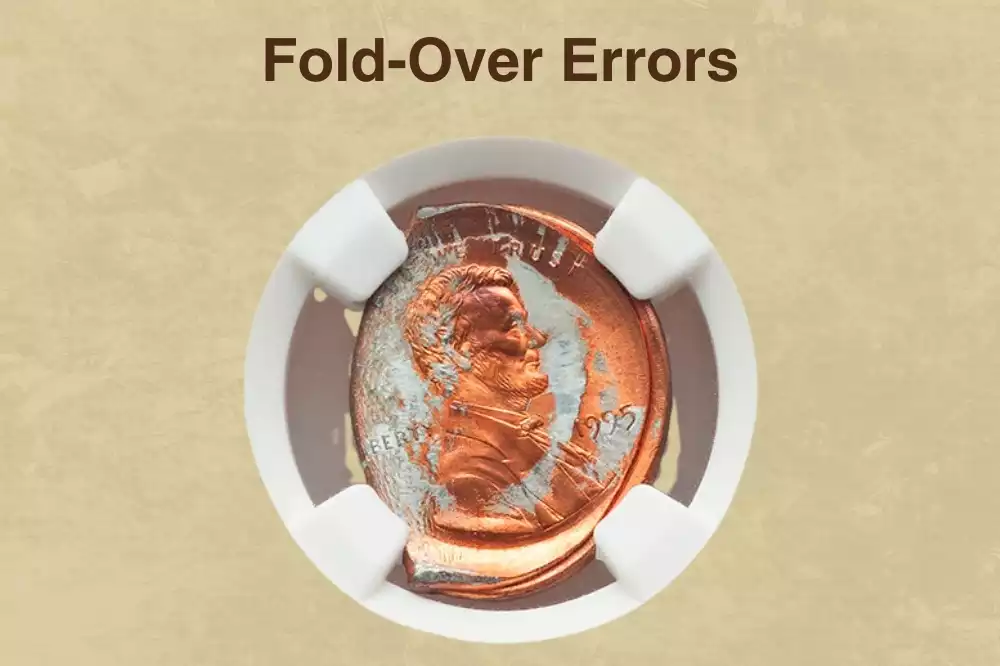
Fold-over errors occur when a portion of the planchet folds onto itself during the striking process, creating a coin where part of the metal is doubled over. The formation happens when the planchet is improperly fed into the coining press or when mechanical issues cause the blank to buckle or fold before or during the strike. This results in a portion of the coin having multiple layers of metal with incomplete design elements where the fold occurred.
The error creates distinctive characteristics: the folded area typically shows weak or missing design details, while the exposed portion displays normal striking. The fold line is usually visible, and the coin may have an irregular shape or thickness variation across its surface.
The 1995 Lincoln cent contained this error, in which part of the metal folded during the striking process, causing the metal portion of the coin to be bent in half.
Values for fold-over errors vary significantly based on the extent and visibility of the fold, the year, and overall condition. These error coins typically command substantial premiums among error collectors.
Known Die Cap Error Years for Modern Lincoln Cent (1959-Date):
23. Rotated Die Errors

A rotated die error is a result of one die not being properly oriented in relation to the opposing die, so when the coin is struck it results in one side being rotated at an incorrect degree. The formation happens when mint dies are installed at an angle or begin to tilt toward one side over time.
These errors are measured in degrees of rotation, and NGC will recognize rotated die mint errors only if there is at least 15 degrees of rotation.
Values vary based on the degree, denomination, coin type and coin grade. While specific pricing information varies, these errors command collector premiums due to their mechanical nature and visual impact when the coin is flipped between obverse and reverse sides.
Known Rotated Die Error Years for Modern Lincoln Cent (1959-Date):
24. Double Denomination Errors

Lincoln Modern Cent Double Denomination Errors represent some of the most dramatic and valuable mint errors in numismatics. This type of error often results from a struck coin accidentally being fed into the press and regular blanks of another coin type. The most common examples involve Lincoln cents overstruck on previously struck Roosevelt dimes, creating fascinating hybrid coins displaying elements of both denominations.
Lincoln cents that are overstruck on Roosevelt dimes have appeared on the market with increasing frequency in the past decade, indicating this is a recurring mint error.
Values of these error coins vary significantly based on grade and visual appeal. A 1996 Lincoln cent overstruck on a Roosevelt dime graded MS-66 sold for $558.13 at Stack’s Bowers’ 2014 Baltimore auction, demonstrating strong collector demand.
These errors hold special significance as they represent a kind of production failures that create one-of-a-kind numismatic specimens, making them highly sought after by error coin specialists and Lincoln cent enthusiasts alike.
Known Double Denomination Error Years for Modern Lincoln Cent (1959-Date):
Modern Penny Design-Specific Errors
25. Doubled Ear Errors

Doubled ear errors exhibit visible doubling specifically in Lincoln’s ear area, creating a distinctive shadow or secondary impression that appears as overlapping lines or contours.
These errors occur during the die production process. When the hub strikes the working die repeatedly with minor positional shifts, Lincoln’s ear area receives overlapping impressions, resulting in the characteristic doubled appearance that gives these varieties their name.
Doubled ear varieties command significant premiums among Lincoln cent specialists due to their distinctive visual characteristics and official recognition. Values depend heavily on grade and specific variety, with higher-grade examples reaching substantial prices in the collector market.
The 1984 Doubled Die Ear variety represents a notable example, with circulated pieces commanding over $3,000 from collectors willing to pay premium prices for authenticated examples. The 1988 Doubled Ear FS-101 and 1997 Doubled Ear FS-101 are both officially recognized varieties included in major reference works.
These varieties have achieved widespread authentication by multiple numismatic organizations and are particularly sought after due to their focused doubling characteristics that make them readily identifiable even to novice collectors, contributing to their strong market demand and collectible status.
Known Double Ear Error Years for Modern Lincoln Cent (1959-Date):
26. Flared “G” Errors

The Lincoln cent “Flared G” error is a die variety that occurs when the designer’s initials “FG” (Frank Gasparro) on the reverse become distorted during the die-making process.
The error forms when excessive die polishing removes metal around the initials, or when hubbing pressure causes the letters to spread.This creates a distinctive appearance where the letter “G” looks spread out or “flared” compared to normal specimens.
The most famous example is the 1988 Flared G penny (FS-901), which represents the most widely recognized and collected specimen of this variety. Values typically range from $20-100+ depending on grade and condition, with higher grades commanding premium prices. A 1988 FS-901 Flared G in MS66BN condition has sold for $1,950 at auction, demonstrating it’s high value and collector’s strong interest.
This variety holds special significance as it showcases how seemingly minor die imperfections can create valuable collectible coins, making it an excellent introduction to Lincoln cent variety collecting.
Known Flared “G” Error Years for Modern Lincoln Cent (1959-Date): 1988
In Conclusion
The modern Lincoln cent series demonstrates that mint errors remain an integral part of contemporary coin production despite advanced quality control measures.
From high-value doubled dies and dramatic striking errors to accessible die breaks and planchet anomalies, these varieties offer collecting opportunities across all budget levels.
As minting technology continues evolving, documented error types provide historical snapshots of production methods, making them increasingly valuable to both specialized collectors and numismatic researchers studying American coinage manufacturing processes.
The post 26 Rare Modern Lincoln Penny Errors Worth Money (Full List with Pictures) appeared first on CoinValueChecker.


